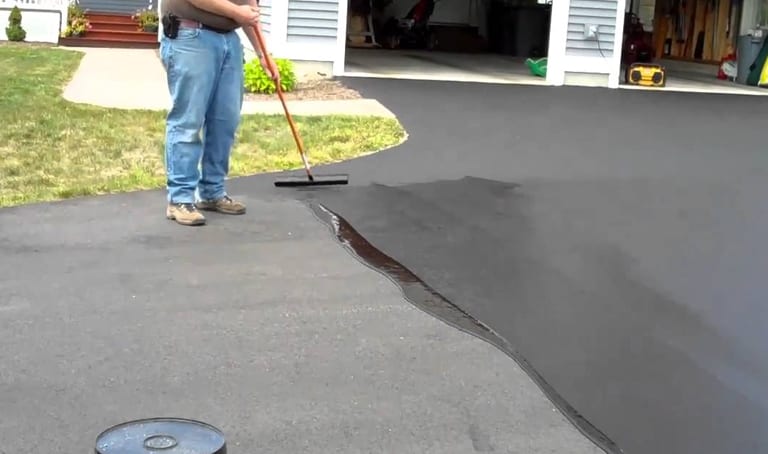Release the Prospective: Regrading and Asphalt Sealing for Industrial Spaces
Wiki Article
Hot Mix Asphalt: A Lasting Solution for Sidewalk
Warm Mix Asphalt (HMA) has actually arised as a leading lasting option for sidewalk services, providing a myriad of innovative technologies and environmental advantages. Its capacity to reuse materials and lower power consumption presents an engaging instance for its fostering in road building jobs. In addition, the lasting performance and longevity of HMA make it a favored choice for framework growth. As the need for environmentally friendly construction methods grows, exploring the nuances of HMA's sustainability can provide useful insights right into the future of pavement options.Ecological Benefits of Hot Mix Asphalt

In Addition, Warm Mix Asphalt aids to mitigate city heat island impacts. Its dark shade absorbs sunshine, reducing the amount of heat mirrored back right into the atmosphere compared to lighter-colored sidewalks. This can decrease ambient temperature levels in city areas, decreasing the need for air conditioning and ultimately minimizing power usage.
In addition, Warm Mix Asphalt contributes to enhanced stormwater administration. Its permeable nature permits water to charge and infiltrate the sidewalk groundwater supplies, reducing overflow and the risk of flooding. These ecological benefits make Hot Mix Asphalt a sustainable selection for paving highways and roadways.
Power Performance in HMA Manufacturing
Is energy performance a critical element in the manufacturing of Hot Mix Asphalt (HMA)? Power plays a significant role in the production of HMA, impacting both cost and ecological sustainability. One key element of energy efficiency in HMA production is the usage of warm mix asphalt (WMA) innovations.In addition, developments in plant modern technologies have led to even more energy-efficient HMA production processes. By maximizing power usage in HMA manufacturing, the industry can minimize its carbon impact while maintaining high-grade pavement products.
Recyclability of Warm Mix Asphalt
The recyclability of Hot Mix Asphalt (HMA) is a critical facet of its sustainability and long-term ecological impact. HMA is among one of the most recycled products in the United States, with over 100 million heaps of recovered asphalt sidewalk (RAP) being recycled annually in new pavement building and construction. Recycling HMA uses numerous ecological advantages, such as decreasing the requirement for virgin products, lowering energy consumption during production, and reducing the quantity of waste sent to land fills.The procedure of reusing HMA includes crushing the existing sidewalk, squashing it right into smaller sized items, and mixing it with new aggregate and asphalt check this site out binder to create a recycled mix. This recycled mix can typically do along with and even hop over to these guys much better than standard HMA, while calling for fewer basic materials and producing reduced greenhouse gas emissions. By incorporating RAP into new pavement projects, road firms can preserve all-natural sources, lower prices, and lessen the ecological footprint of road building and maintenance activities. Overall, the recyclability of HMA plays a significant role in advertising lasting techniques within the sidewalk market.

Long-Term Efficiency of HMA
Asphalt sidewalks demonstrate durability and resilience over an extensive period, reflecting the lasting efficiency of Warm Mix Asphalt (HMA) The longevity of HMA can be connected to its ability to stand up to heavy website traffic loads, severe weather condition problems, and the impacts of aging. Research studies have actually revealed that properly designed and properly constructed HMA pavements can last for 20 years or more with regular upkeep. The key to optimizing the lasting efficiency of HMA exists in making use of premium materials, following best practices in construction, and implementing reliable upkeep methods. Appropriate drain, routine inspections, and timely fixings are crucial for maintaining the architectural stability of HMA pavements in time. Additionally, advancements in HMA modern technology, such as the use of polymer-modified binders and warm mix asphalt, have better boosted the toughness and longevity of HMA sidewalks. By prioritizing top quality building and maintenance techniques, HMA remains to prove itself as a cost-effective and lasting service for durable pavement framework.
HMA: Longevity and Sustainability
Showing both sturdiness and sustainability, Hot Mix Asphalt (HMA) has actually ended up being a cornerstone in the building and construction of resilient look at here now pavement frameworks - angled parking. HMA's durability originates from its capability to withstand hefty tons, rough climate condition, and high website traffic volumes, making it a reliable selection for highways, highways, and flight terminal paths. The structure of HMA, which typically includes accumulations, binder, and filler, plays an important duty in enhancing its long life and resistance to tear and use
Moreover, HMA's sustainability lies in its recyclability and energy-efficient manufacturing procedure. The ability to recycle reclaimed asphalt pavement (RAP) in new HMA combinations reduces the demand for virgin products and reduces the ecological impact of sidewalk construction and maintenance. Additionally, the power efficiency of generating HMA hinges on its lower mixing temperature levels contrasted to various other pavement products, leading to decreased power intake and greenhouse gas exhausts.
Conclusion
In conclusion, hot mix asphalt (HMA) supplies a lasting option for pavement with its environmentally pleasant features. HMA's recyclability, energy efficiency in manufacturing, and lasting sturdiness make it an environmentally friendly choice for roadway building.
HMA is one of the most recycled materials in the United States, with over 100 million tons of redeemed asphalt pavement (RAP) being reused every year in new sidewalk construction.The process of reusing HMA includes crushing the existing sidewalk, crushing it right into smaller items, and mixing it with brand-new aggregate and asphalt binder to develop a recycled mix.Asphalt pavements show toughness and resilience over an extensive period, mirroring the long-lasting efficiency of Hot Mix Asphalt (HMA) In addition, developments in HMA modern technology, such as the usage of polymer-modified binders and cozy mix asphalt, have actually further boosted the sturdiness and longevity of HMA pavements. The capacity to reuse redeemed asphalt pavement (RAP) in new HMA combinations decreases the need for virgin materials and lessens the ecological impact of pavement building and construction and maintenance.
Report this wiki page